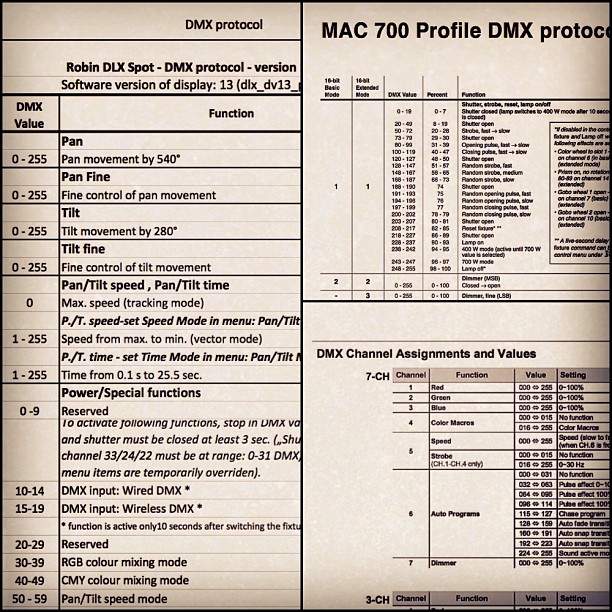Illuminating DMX: Part 3 A- DMX Protocol Charts
In basic terms you could think of a DMX protocol chart as an address book. They list what paramater of a lighting fixture is controlled at each DMX address. The charts are usually found in an instrument's owners manual.
Why Do We Need to Know This?
If we look back at "Illuminating DMX: Part 2- Addressing", there's an example using a simple controller, two dimmer packs, and some par cans. One lighting instrument was controlled by one fader on the controller. This was a typical system a few years ago.
Recently however, LED lighting systems, and moving head (often referred to as movers) lights have gotten extremely affordable. These instruments use multiple DMX channels, and therefore multiple faders. The chart will tell you what fader to move to control which function of the light.
What Are We Controlling?
The functions of a lighting instrument vary from manufacturer to manufacturer. They can also vary depending on what mode the instrument is operating in. Some units even allow you to change the number of channels they use. Let's take a look at some of the parameters.
We'll start with some typical mover parameters:
- Pan- this turns the head of the mover. Like shaking your head "No."
- Tilt- moves the head up and down. Like shaking your head "Yes"
- Zoom- changes the size or diamater of the projected beam of light
- Focus- Changes how sharp the projected beam of light or image from the light appears. Similar to focusing a projector
- Color Wheel(s)- Some instruments have a wheel with fixed colors such as red, blue, green, violet, etc. This paramater would turn the wheel to the selected color. Others use a series of three wheels to mix colors.
- Gobo- A Gobo is a metal or glass piece that has a pattern on it, that Goes Between (hence the term Gobo) the lamp and the lenses that project an image, or can break the light beam up so it makes neat patterns in the air. A classic yet semi flawed example of this is the search light Commissioner Gordon uses to signal Batman.
- Dimmer- This one's pretty straight forward. It changes the intensity of the light blasting out of the instrument.
And now some typical LED wash light parameters:
- Red- Changes the intensity of the Red LEDs from 0 to 100%
- Blue- Changes the intensity of the Blue LEDs from 0 to 100%
- Green- Changes the intensity of the Green LEDs.
- Color Macros- Depending on what DMX value is transmitted, this will change the light to a pre-set color. This paramater usually overrides the Red Blue & Green (RGB) settings.
- Strobe- makes the instrument flash.
- Auto Programs- this will engage some built in color change patterns
- Speed- This will change how fast the auto-programs cycle.
- Dimmer- This would function as a master dimmer for the instrument
So What's Next?
For the next post in this series we'll take a look at an actual DMX Protocol chart and break down each paramater and how that relates to faders on a controller... Stay tuned!
~Andy
See Illuminating DMX: Part 2- Addressing here.
Continue to Illuminating DMX: Part 3B- DMX Protocol Charts vs Faders here.


